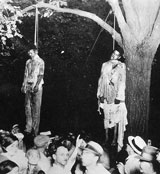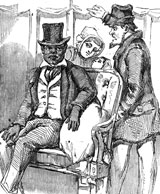
The Strange Culture of Jim Crow (circa 1877–1897)
After the defeat of Reconstruction, U. S. Blacks built communities and made themselves, to paraphrase historian Leon Litwack, “into a people,” surrounded by anxious, fearful Whites. They tried moving to new lands, which they called “exodusting,” built churches and schools and whole communities, sought allies, and defended their lives, dignity, and rights. But Whites steadily cut into Blacks’ freedom and earnings for decades, using contempt and comedy, fear and force and laws, to preserve what they saw as their racial purity, hard-earned status and values. Yet in spite of Blacks’ constricted lives, they burrowed deep into the consciousness and culture of the American states.
We plan to produce this new Between Civil War and Civil Rights program in multi-media form, with a 1-hour core audio version for public radio broadcast. Watch this page as we develop the script and sounds! Send us your thoughts, narratives, images, ideas, texts, themes and especially sounds, and please join us in developing, funding and producing, the most effective program possible.
We’ll document and debate America’s political and cultural changes, weaving the tale from such elements as:
- Communities like New Orleans; Mound Bayou Mississippi, with its ex-slave musical band; “exodusting” to Kansas in 1879 and beyond…
- Institutions: schooling in faith, making teachers, universities, and education policy; early civil rights groups; share-cropping and peonage; and Wilmington NC’s reactionary white brass band, the Kornet Kavalier Klub…
- Antagonists: “Old lion” Frederick Douglass, “the fool” Albion Tourgée, and young champions Ida B. Wells, W. E. B. Du Bois versus John van Evrie and the writers of racism, “the Bourbons”, and the “Yellow Peril” anti-immigrant agitators…
- Efforts: Progressives and Populists; The Atlanta Compromise offer; New Orleans creoles organize the Plessy v. Ferguson test-case; and Coon songs contest African-American culture, and
- Events: anti-immigrant Acts, anti-suffrage laws, and “The Lost Cause” Remembered and Reconciled.





